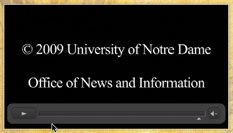Stolen Videos: 3 Ways to Protect Yourself Before You Need To
From the Chronicle of Higher Education:
A new company called Academic Earth offers free online videos of lectures from some of the world’s most renowned scholars teaching at leading universities. The company has simply grabbed the videos off the universities’ own Web sites and plans to offer tools to students who want to talk about the content — along with a chance to grade the quality of the lectures.

The company in question, Academic Earth, is using these videos legally (so the claim goes). Many content producers are realizing that content doesn’t just live on their own websites. It’s being copied and distributed and transformed. And even when you can fight that battle, it’s an expensive and time-consuming process: in other words, few even bother.
By publishing it on the web, you’re implicitly giving permission to reproduce the content. That’s the way the web works—you have to download a copy in order to even view it. But that doesn’t mean you’ve given permission to reproduce for any purpose. Just because it’s easy to do doesn’t make it legal. Remember Napster? Even more frustratingly, some of the licenses (Creative Commons, in this case) open the door to these sometimes questionable uses.
Clarify Your License
Everything you create and fix is copyrighted. This blog post is copyrighted. The drawing you scribbled on your napkin is copyrighted. You don’t need to fill out forms, register anything, or pay any fees. It’s automatic. And it’s defensible in court.
If you want people to be able to use and share freely, you may consider a license such as Creative Commons or GPL. Check out KeepYourCopyrights for a good resource on this and more.
But as copyright owner, it often helps to clarify your intents and license to visitors and users. Spell it out and provide resources for people to better understand how they can use your content.
Make Attribution Easy

It’s one thing to ask people to give you credit, but over time it can be very difficult to maintain that attribution. As content gets passed around and transformed, the end product may be difficult to trace back to you.
For video, consider adding intro and ending clips with your mark, copyright statement, your URL, etc. Keep it simple: don’t cram 250 words into a single frame. Have you ever read the FBI warning at the beginning of a movie?
Make It Easy to Share and Embed

This is a bit counter-intuitive, but it’s important: people will find a way around whatever protections you put in place. If you’re producing great content that people want to share, you might as well make it easy on them. Turn on embedding or allow them to easily download without cheating the system. If users have to hack through your fences to get to the video, they probably won’t mind cutting the 3 seconds of copyright notice off the end of your video.
An Ounce of Prevention
Copyright is one area where the law has not kept pace with the technology. What used to be a major production is now a cell phone or Flip camera away. Creating valuable content can be done very quickly, but the law changes slowly. Trying to protect yourself in court can be very costly. It pays to be proactive in protecting your brand and your content.